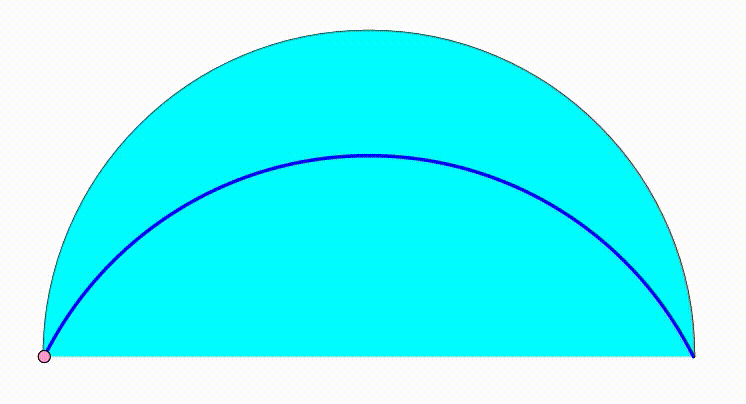Dynamic Geometry: P99
 The diagram shows a black semicircle with radius
. The cyan and green semicircle are growing and shrinking freely on the black semicirle's diameter. The purple circle is internally tangent to the black semicircle and tangent to both green and cyan semicircle. The red and orange circles are internally tangent to the black semicircle and tangent to the purple circle and to one of the bottom semicircles. The tangency points between the orange circle, the red circles and the purple circle trace a
locus
(blue curve). The area bounded by the blue curve and the black semicircle's diameter can be expressed as:
The diagram shows a black semicircle with radius
. The cyan and green semicircle are growing and shrinking freely on the black semicirle's diameter. The purple circle is internally tangent to the black semicircle and tangent to both green and cyan semicircle. The red and orange circles are internally tangent to the black semicircle and tangent to the purple circle and to one of the bottom semicircles. The tangency points between the orange circle, the red circles and the purple circle trace a
locus
(blue curve). The area bounded by the blue curve and the black semicircle's diameter can be expressed as:
where , , and are positive integers. and are coprime. and are prime. Find .
The answer is 12.
This section requires Javascript.
You are seeing this because something didn't load right. We suggest you, (a) try
refreshing the page, (b) enabling javascript if it is disabled on your browser and,
finally, (c)
loading the
non-javascript version of this page
. We're sorry about the hassle.
Let the center of the unit semicircle be O ( 0 , 0 ) , the origin of the x y -plane, and its diameter A B , the center of the purple circle be P , ∠ P O B = θ , and t = tan 2 θ . Also let an arbitrary point on the locus or the tangent point of the purple and orange circles be T 2 ( x , y ) . From the calculations in Dynamic Geometry: P80 Series, we have
⎩ ⎪ ⎨ ⎪ ⎧ x = t 2 + 2 t + 5 5 − t 2 y = t 2 + 2 t + 5 4 t
Then the area under the locus is given by:
A = ∫ 0 t = 5 x d y = ∫ 0 t = 5 t 2 + 2 t + 5 5 − t 2 d ( t 2 + 2 t + 5 4 t ) = ∫ 0 5 ( t 2 + 2 t + 5 ) 3 4 ( 5 − t 2 ) 2 d t = 4 5 tan − 1 2 − 2 1
Therefore p + q + m + n = 5 + 4 + 2 + 1 = 1 2 .